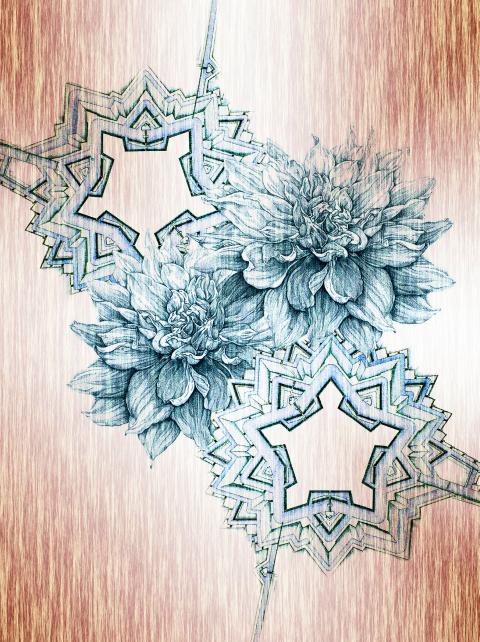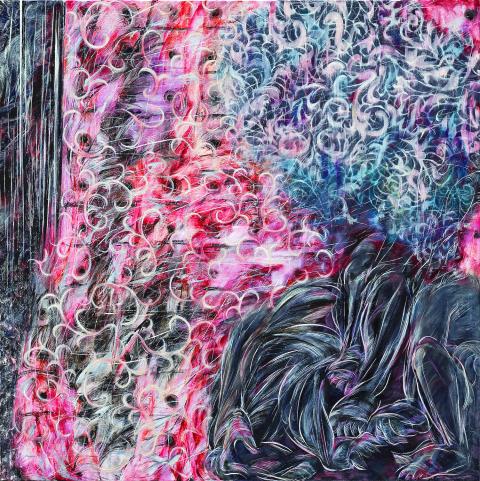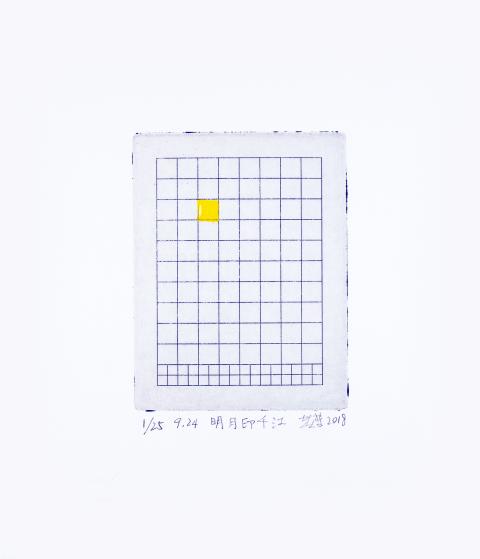Tsong Pu (莊普) is known for creating meticulous geometric paintings. His signature method of composition is to organize arrangements of color fields using one-centimeter squared grids. Although abstract and minimal, the works reference histories, sentiments and perspectives that relate to relationships between man, nature and the world. Tsong’s solo exhibition, Illusions of the Universe (幻覺的宇宙), features new paintings on canvas, watercolor drawings and installations created in the last two years. The title of the show refers to the artist’s interest in studying physical phenomena, such as analyses of light, reflection and material.
■ Eslite Gallery (誠品畫廊), 5F, 11 Songgao Rd, Taipei City (台北市松高路11號5樓), tel: (02) 8789-3388. Open Tuesdays to Sundays from 11am to 7pm
■ Tomorrow; until Nov. 17

Photo Courtesy of Bluerider Art
Mind Set Art Center (安卓藝術) presents Appearances under Erasure (擦抹情境), a solo exhibition by Juin Shieh (謝鴻均). Shieh’s drawings and paintings are intimately connected with her personal life experiences, intellectual enquiries and explorations about the social structure of contemporary society. In her studio, the artist maintains a meditative process of manipulating surfaces, creating forceful strokes, then smudging or erasing them as a means for reconstruction. The exhibition includes pictures inspired by her studies of grass fields while taking her family dog on walks in the countryside. She contemplates the cycle of life found in the wilderness and in man-made environments, seeking to grasp the dialectical relationships between man, nature and the universe.
■ Mind Set Art Center (安卓藝術) 180, Heping E Rd, Taipei City (台北市和平東路180號), tel: (02) 2365-6008. Open Tuesdays to Saturdays from 11am to 6pm
■ Tomorrow; until Nov. 30

Photo Courtesy of Taipei Contemporary Art Center
The 26th edition of Taipei’s long running contemporary art fair, Art Taipei (台北國際藝術博覽會), kicks off today. The fair will feature 141 international and local galleries, with a thematic focus on the reproduction of light. According to the fair’s press release, light is a metaphor for infinite possibilities and a fundamental sign of creation. In addition to the anticipated gallery presentations, the fair will also include a retrospective of Taiwanese modern art after the end of martial law, and a section — MIT — that is dedicated to showcasing young local talent.
■ Taipei World Trade Center Exhibition Hall 1 (台北世貿中心展覽1館), 5, Sec 5, Xinyi Rd, Taipei City (台北市信義五段5號), tel: (02) 2659-0798. Open today from 2 to 7pm, tomorrow and Sunday from 11 am to 7pm, and Monday from 11 am to 6pm
■ Today until Monday

Photo Courtesy of Mindset Art Center
This year marks the 100th anniversary of Bauhaus, a pioneering school of applied arts and architecture that operated in Weimar and subsequently Dessau, Germany between the two world wars. As part of its internationally traveling program, Virtual Bauhaus (虛擬包浩斯) will be opening today at the Kuandu Museum of Fine Arts (關渡美術館). The show is a recreation of the school’s building in Dessau, through which visitors can walk and experience its iconic modern architecture and design.
■ Kuandu Museum of Fine Arts (關渡美術館), 1 Xueyuan Rd, Taipei City (台北市學園路1號), tel: (02) 2896-1000 X 2432. Open Tuesdays to Sundays from 10am to 5pm
■ Until Jan. 5

Photo Courtesy of Eslite Gallery
Beatrice Glow is an interdisciplinary artist working in a variety of mediums, including performance, painting, experiential technology, olfactory art and video. For Flowers and Forts, currently on view at Taipei Contemporary Art Center (台北當代藝術中心), Glow presents a series of video works, prints on silk and parts of her ongoing research project between Mannahatta (today’s Manhattan) and Rhun of the Banda Islands in Indonesia. Both islands share traces of traumatic pasts under European colonization and were exchanged by the Dutch and English in 1667. Glow’s research revolves around the wild flowers growing around historical forts, which suggests a narrative of exploitation, regeneration and resilience.
■ Taipei Contemporary Art Center (台北當代藝術中心), 11, Ln 49, Baoan St, Taipei City (保安街49巷11號), tel: (02) 2550-1231. Open Tuesday to Sunday from 1pm to 7pm
■ Until Nov. 10

US President Donald Trump may have hoped for an impromptu talk with his old friend Kim Jong-un during a recent trip to Asia, but analysts say the increasingly emboldened North Korean despot had few good reasons to join the photo-op. Trump sent repeated overtures to Kim during his barnstorming tour of Asia, saying he was “100 percent” open to a meeting and even bucking decades of US policy by conceding that North Korea was “sort of a nuclear power.” But Pyongyang kept mum on the invitation, instead firing off missiles and sending its foreign minister to Russia and Belarus, with whom it

When Taiwan was battered by storms this summer, the only crumb of comfort I could take was knowing that some advice I’d drafted several weeks earlier had been correct. Regarding the Southern Cross-Island Highway (南橫公路), a spectacular high-elevation route connecting Taiwan’s southwest with the country’s southeast, I’d written: “The precarious existence of this road cannot be overstated; those hoping to drive or ride all the way across should have a backup plan.” As this article was going to press, the middle section of the highway, between Meishankou (梅山口) in Kaohsiung and Siangyang (向陽) in Taitung County, was still closed to outsiders

President William Lai (賴清德) has championed Taiwan as an “AI Island” — an artificial intelligence (AI) hub powering the global tech economy. But without major shifts in talent, funding and strategic direction, this vision risks becoming a static fortress: indispensable, yet immobile and vulnerable. It’s time to reframe Taiwan’s ambition. Time to move from a resource-rich AI island to an AI Armada. Why change metaphors? Because choosing the right metaphor shapes both understanding and strategy. The “AI Island” frames our national ambition as a static fortress that, while valuable, is still vulnerable and reactive. Shifting our metaphor to an “AI Armada”

The Chinese Communist Party (CCP) has a dystopian, radical and dangerous conception of itself. Few are aware of this very fundamental difference between how they view power and how the rest of the world does. Even those of us who have lived in China sometimes fall back into the trap of viewing it through the lens of the power relationships common throughout the rest of the world, instead of understanding the CCP as it conceives of itself. Broadly speaking, the concepts of the people, race, culture, civilization, nation, government and religion are separate, though often overlapping and intertwined. A government